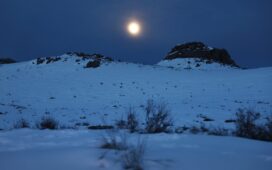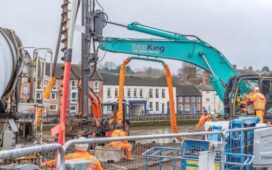An explorer has travelled the length and breadth of Britain to photograph over 400 mysterious hidden ancient sites.
Dave Hamilton, 44, ventured across the country from the Isle of White to the Orkney archipelago to uncover ruins which have stood for up to 10,000 years.
He avoided famous and obvious sites like Stonehenge and decided to focus on little-known lost ruins.
The journey includes encounters with sacred tombs and caves, stone circles, Bronze Age brochs and Iron Age hillforts.
They are captured in his new book, Wild Ruins BC, where he retraced the footsteps of our prehistoric ancestors.
Scroll down for video


Borvemoor on the Isle of Harris. This remote island is home to only 1,916 people and is renowned for its gin. This prehistoric monument is a relic from an era thousands of years ago


Bryn Cader Faner north Wales. It is a Bronze Age round cairn which lies to the east of the small hamlet of Talsarnau. Perched atop a mountain, it resembles a crown of thorns made out of rocks


Machrie Moor standing stones on the Isle of Arran. It is part of a rich archaeological landscape that dates back to between 3500 and 1500 BC and includes stone circles, standing stones, burial cairns and cists
Mr Hamilton says one of his favourite sites is Brenig 51 in north Wales which was a 70ft (21 metre) ancient Bronze Age burial platform.
Bryn Cader Faner, also in north Wales and perched atop a mountain, resembles a crown of thorns made out of rocks.
The chambered long barrow at Stoney Littleton in Somerset, which can clearly be seen from the sky, also served as a burial tomb.
In the early 19th century the Reverend John Skinner entered through a hole in the roof and found human bodies still within each chamber, along with pottery fragments.
The giant 4,500 year old Rudston Monolith in north Yorkshire is 25ft (7.5 metres) tall, towering over the graves in the churchyard.
The ‘Langdale Axe Factory’ near the summit of the Pike of Stickle in the Lake District was a production site for stone axes which were distributed around Britain.


Callenish stone circle in Lewis originate from the late Neolithic period and are common on some of the isolated islands off the coast of the UK


Avebury in Wiltshire. Avebury is a Neolithic henge monument made of three stone circles surrounding the village. The henge is more than three quarters of a mile in circumference and it would have been originally up to 29 feet deep


T’reri Cereri in north Wales. Mr Hamilton avoided famous and obvious sites like Stonehenge and decided to focus on little-known lost ruins scattered across the country from the Isle of White to the Orkney archipelago


T’reri Cereri, Wales. It is one of the images cpatured by Mr Hamilton for his book, Wild Ruins BC, in which seeks to retrace the footsteps of our prehistoric ancestors


Brenig in North Wales. A lake built nearby began in 1973 and was completed in 1976. Construction of the lake turned up a range of Bronze Age artefacts from Mesolithic hunter/gatherers


Castlerigg in the Lake district. It overlooks the Thirlmere Valley with the mountains of High Seat and Helvellyn as a backdrop. It is hought to have been constructed about 3000 BC
The Bronze Age stones of Scorhill Circle in Dartmoor mark an ancient place of worship, as does the Glen Cairn and Giant’s Grave in the Scottish heartland.
The Preseli Hills quarry in Pembrokeshire is said to be the site from which the stones used for Stonehenge originated from before being transported 180 miles (290 km) down to Wiltshire.
Mr Hamilton, from Froome, Somerset, said: ‘I set out to discover the lost remains and mysterious stones that lie hidden in some of the most beautiful landscapes of Britain.
‘It took three years to visit all the sites but it was a great project to work on, although I didn’t realise there were quite so many of them!
‘It has been fascinating to learn more about the world of our ancestors, from the earliest footprints trodden on British shores to the coming of the Romans.
‘These prehistoric civilisations were remarkably sophisticated and the sites they created in some instances are mind-blowing.’


Thornbrough Head in Yorkshire. Mr Hamilton, from Froome, Somerset, said: ‘I set out to discover the lost remains and mysterious stones that lie hidden in some of the most beautiful landscapes of Britain’


The giant 4,500 year old Rudston Monolith in north Yorkshire is 25ft (7.5 metres) tall, towering over the graves in the churchyard


Hollingbury hillfort near Brighton.. It encloses about 3.6 hectares and dates back to the sixth century BC and sits 584 feet (178 m) above sea level


Sma Glen Cairn in Scotland. Ossian’s Stone is 7.5 foot long and 5 foot wide. Mr Hamilton said it took three years to visit all the sites


Stoney Littleton in Somerset is an fine example of a chambered long barrow built during the Neolithic period (about 4000–2500 BC)


The chambered long barrow at Stoney Littleton (pictured) in Somerset, which can clearly be seen from the sky, also served as a burial tomb


Stone Henge quarry, Pembrokeshire. The Preseli Hills quarry in Pembrokeshire is said to be the site from which the stones used for Stonehenge originated from before being transported 180 miles (290 km) down to Wiltshire


Longstone, Mottiston Down on the Isle of Wight. It measures more than 13 feet high and six feet wide and is. According to local legend, St Catherine and the Devil had a contest to see who should control the Isle of Wight


Langdale axe factory in the Lakes.The ‘Langdale Axe Factory’ near the summit of the Pike of Stickle in the Lake District was a production site for stone axes which were distributed around Britain


Scorehill stone circle on Dartmoor. It is located on Gidleigh Common near the village of the same name in the north east of Dartmoor. It is an English Heritage scheduled monument and has been described as Devon’s finest stone circle


Midhowe Broch in Orkney. It is an iron-age broch located on the west coast of the island of Rousay














